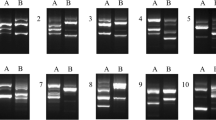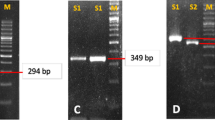Abstract
Mixed infections and heteroresistance of Helicobacter pylori contribute to decreased efficacy of treatments. This study aimed to investigate frequency of clarithromycin heteroresistance and its link with mixed infections, medication history, and disease severity. A total of 40 pairs of H. pylori strains were isolated from the antrum and corpus of 97 patients. Susceptibility of the strains to clarithromycin was measured by agar dilution method. Site-specific mutations of 23S rRNA at A2143G, A2142G, and A2142C positions were analyzed by PCR and genomic relatedness of pairs of the strains was determined by random amplified polymorphic DNA (RAPD)-PCR. The results showed a prevalence of 35% (14/40) clarithromycin resistance. Diversity of the antrum and corpus isolates in resistance to clarithromycin was detected among 17.5% (7/40) of the patients. Similarly, diversity in MIC value was also detected in two patients infected with the sensitive strains. Significant difference in frequency of resistance was detected among patients with peptic ulcer disease (PUD) (MIC90 32 μg/mL) and severe gastritis (MIC90 16 μg/mL), compared with those who suffered from non-ulcer dyspepsia (NUD) (MIC90 8 μg/mL) and chronic gastritis (MIC90 0.25 μg/mL). MIC values showed 8–32 folds increased levels in the corpus. A2142G, A2143G, and A2142C mutations were detected in three, two, and two patients, respectively, but not observed in 46% of the resistant strains. RAPD-PCR fingerprints showed identical molecular patterns for the isolates of the corpus and antrum in each patient. In conclusion, microevolution of H. pylori strains during chronic infection, rather than mixed infection, and inappropriate medication appear to be main reasons of treatment failure in adults.

Similar content being viewed by others
References
Agudo S, Pérez-Pérez G, Alarcón T, López-Brea M (2010) High prevalence of clarithromycin-resistant Helicobacter pylori strains and risk factors associated with resistance in Madrid, Spain. J Clin Microbiol 48(10):3703–3707
Alebouyeh M, Yadegar A, Farzi N, Miri M, Zojaji H, Gharibi S, Fazeli Z, Ebrahimi Daryani N, Asadzadeh Aghdaei H, Zali MR (2015) Impacts of H. pylori mixed-infection and heteroresistance on clinical outcomes. Gastroenterology and Hepatology from bed to bench 8(Suppl.1):S1–S5
Ayala G, Galván-Portillo M, Chihu L, Fierros G, Sánchez A, Carrillo B, Román A, López-Carrillo L, Silva-Sánchez J, Study Group J (2011) Resistance to antibiotics and characterization of Helicobacter pylori strains isolated from antrum and body from adults in Mexico. Microb Drug Resist 17(2):149–155
Bohr UR, Primus A, Zagoura A, Glasbrenner B, Wex T, Malfertheiner P (2002) A group specific PCR assay for the detection of Helicobacteraceae in human gut. Helicobacter 7:378–383
Boyanova L (2017) Amoxicillin/clarithromycin. Reactions 1646:34–38
Dorer MS, Sessler TH, Salama NR (2011) Recombination and DNA repair in Helicobacter pylori. Annu Rev Microbiol 65:329–348
Fakheri H, Bakhshi Z, Bari Z, Alhooei S (2016) Effects of clarithromycin-containing quadruple therapy on Helicobacter Pylori eradication after nitroimidazole-containing quadruple therapy failure. Middle East J Dig Dis 8(1):51–56
Farzi N, Malekian T, Alebouyeh M, Vaziri F, Zali MR (2015) Genotype diversity and quasispecies development of Helicobacter pylori in a single host. Jpn J Infect Dis 68(3):176–180
Finger SA, Velapatiño B, Kosek M, Santivañez L, Dailidiene D, Quino W, Balqui J, Herrera P, Berg DE, Gilman RH (2006) Effectiveness of enterobacterial repetitive intergenic consensus PCR and random amplified polymorphic DNA fingerprinting for Helicobacter pylori strain differentiation. Appl and Environ Microbiol 72(7):4713–4716
Hu Y, Zhang M, Lu B, Dai J (2016) Helicobacter pylori and antibiotic resistance, a continuing and intractable problem. Helicobacter 21:349–363
Hu Y, Zhu Y, Lu NH (2017) Novel and effective therapeutic regimens for Helicobacter pylori in an era of increasing antibiotic resistance. Front Cell Infect Microbiol 7:168
Huang JY, Sweeney EG, Guillemin K, Amieva MR (2017) Multiple acid sensors control Helicobacter pylori colonization of the stomach. PLoS Pathog 13(1):e1006118
Huang XW, Luo RH, Zhao Q, Shen ZZ, Huang LL, An XY, Zhao LJ, Wang J, Huang YZ (2011) Helicobacter pylori induces mitochondrial DNA mutation and reactive oxygen species level in AGS cells. Int J Med Sci 8(1):56–67
Ji Z, Han F, Meng F, Tu M, Yang N, Zhang J (2016) The association of age and antibiotic resistance of Helicobacter Pylori: a study in Jiaxing City, Zhejiang Province, China. Medicine 95(8):e2831
Kang JM, Kim N, Shin CM, Lee HS, Lee DH, Jung HC, Song IS (2012) Predictive factors for improvement of atrophic gastritis and intestinal metaplasia after Helicobacter Pylori eradication: a three-year follow-up study in Korea. Helicobacter 17(2):86–95
Kao CY, Lee AY, Huang AH, Song PY, Yang YJ, Sheu SM, Chang WL6, Sheu BS, Wu JJ (2014) Heteroresistance of Helicobacter pylori from the same patient prior to antibiotic treatment. Infect Genet Evol 23:196–202
Kao CY, Sheu BS, Wu JJ (2016) Helicobacter pylori infection: an overview of bacterial virulence factors and pathogenesis. Biom J 39(1):14–23
Kauser F, Hussain MA, Ahmed I, Srinivas S, Devi, SM, Majeed AA, Rao KR, Khan AA, Sechi LA, Ahmed N (2005) Comparative genomics of Helicobacter pylori isolates recovered from ulcer disease patients in England. BMC Microbiol 5:32
Khademi F, Poursina F, Hosseini E, Akbari M, Safaei HG (2015) Helicobacter pylori in Iran: a systematic review on the antibiotic resistance. Iran J Basic Med Sci 18(1):2–7
Kim JJ, Kim JG, Kwon DH (2003) Mixed-infection of antibiotic susceptible and resistant Helicobacter pylori isolates in a single patient and underestimation of antimicrobial susceptibility testing. Helicobacter 8(3):202–206
Kong YJ, Yi HG, Dai JC, Wei MX (2014) Histological changes of gastric mucosa after Helicobacter pylori eradication: a systematic review and meta-analysis. World J Gastroenterol 20(19):5903–5911
Malekzadeh R, Mohamadnejad M, Siavoshi F, Massarrat S (2004) Treatment of Helicobacter pylori in Iran: low efficacy of recommended western regimens. Arch Iranian Med 7(1):1–8
Mokhtare M, Agah S, Fakheri H, Hosseini V, Hemami MR, Ghafoori SMS (2015) Efficacy of clarithromycin containing bismuth–based regimen as a second-line therapy in Helicobacter pylori eradication. Middle East J Dig Dis 7(2):75–81
Nishizawa T, Suzuki H (2014) Mechanisms of Helicobacter pylori antibiotic resistance and molecular testing. Front Mol Biosci 1
Norazah A, Rasinah WZ, Zaili Z, Aminuddin A, Ramelah M (2009) Analysis of PCR-RAPD DNA and antibiotic susceptibility profiles of antrum and corpus isolates of Helicobacter pylori from Malaysian patients. Malays J Pathol 31(1):29–34
Pan ZJ, Su WW, Tytgat GNJ, Dankert J, van der Ende A (2002) Assessment of clarithromycin-resistant Helicobacter pylori among patients in Shanghai and Guangzhou, China, by primer-mismatch PCR. J Clin Microbiol 40(1):259–261
Peek RM, Blaser MJ (2002) Helicobacter pylori and gastrointestinal tract adenocarcinomas. Nat Rev Cancer 2(1):28–37
Rimbara E, Noguchi N, Kijima H, Yamaguchi T, Kawai T, Sasatsu M (2007) Mutations in the 23S rRNA gene of clarithromycin-resistant Helicobacter pylori from Japan. Int J Antimicrob Agents 30(3):250–254
Saberi-Firoozi M, Nejabat M (2006) Experiences with Helicobacter pylori treatment in Iran. Iran J Med Sci 31(4):181–185
Selgrad M, Tammer I, Langner C, Bornschein J, Meißle J, Kandulski A, Varbanova M, Wex T, Schlüter D, Malfertheiner P (2014) Different antibiotic susceptibility between antrum and corpus of the stomach, a possible reason for treatment failure of Helicobacter pylori infection. World J Gastroenterol 20(43):16245–16251
Sgouras DN, Trang TTH, Yamaoka Y (2015) Pathogenesis of Helicobacter pylori infection. Helicobacter 20(S1):8–16
Shimizu T, Marusawa H, Watanabe N, Chiba T (2015) Molecular pathogenesis of Helicobacter pylori-related gastric cancer. Gastroenterol Clin N Am 44(3):625–638
Shokrzadeh L, Alebouyeh M, Mirzaei T, Farzi N, Zali MR (2015) Prevalence of multiple drug-resistant Helicobacter pylori strains among patients with different gastric disorders in Iran. Microb Drug Resist 21(1):105–110
Teh X, Khosravi Y, Lee WC, Leow AHR, Loke MF, Vadivelu J, Goh KL (2014) Functional and molecular surveillance of Helicobacter pylori antibiotic resistance in Kuala Lumpur. PLoS One 9(7):e101481
Thung I, Aramin H, Vavinskaya V, Gupta S, Park J, Crowe S, Valasek M (2016) The global emergence of Helicobacter pylori antibiotic resistance. Aliment Pharmacol Ther 43(4):514–533
Vianna JS, Ramis IB, Ramos DF, Von Groll A, Silva PEAD (2016) Drug resistance in Helicobacter pylori. Arq Gastroenterol 53(4):215–223
Waldum HL, Kleveland PM, Sørdal ØF (2016) Helicobacter pylori and gastric acid: an intimate and reciprocal relationship. Ther Adv Gastroenterol 9(6):836–844
Wroblewski LE, Piazuelo MB, Chaturvedi R, Schumacher M, Aihara E, Feng R, Noto JM, Delgado A, Israel DA, Zavros Y, Montrose MH, Shroyer N, Correa P, Wilson KT, Peek RMJR (2014) Helicobacter pylori targets cancer-associated apical-junctional constituents in gastroids and gastric epithelial cells. Gut 64(5):720–730
Zerbetto De Palma G, Mendiondo N, Wonaga A, Viola L, Ibarra D, Campitelli E, Salim N, Corti R, Goldman C, Catalano M (2017) Occurrence of mutations in the antimicrobial target genes related to levofloxacin, clarithromycin, and amoxicillin resistance in Helicobacter pylori isolates from Buenos Aires city. Microb Drug Resist 23(3):351–358
Acknowledgments
The authors of this article like to thank all staff of endoscopy unit of Ayatollah Taleghani Hospital and Foodborne and Waterborne Diseases Research Center for their sincere help and assistance.
Funding
This study was part of a fellowship dissertation and financially supported by a grant from Research Institute for Gastroenterology and Liver Diseases, Shahid Beheshti University of Medical Sciences, Tehran, Iran.
Author information
Authors and Affiliations
Corresponding authors
Ethics declarations
This study was approved by the Ethics Committee of Shahid Beheshti University of Medical Sciences.
Conflict of interest
The authors declare that they have no conflict of interest.
Rights and permissions
About this article
Cite this article
Farzi, N., Behzad, C., Hasani, Z. et al. Characterization of clarithromycin heteroresistance among Helicobacter pylori strains isolated from the antrum and corpus of the stomach. Folia Microbiol 64, 143–151 (2019). https://doi.org/10.1007/s12223-018-0637-9
Received:
Accepted:
Published:
Issue Date:
DOI: https://doi.org/10.1007/s12223-018-0637-9




